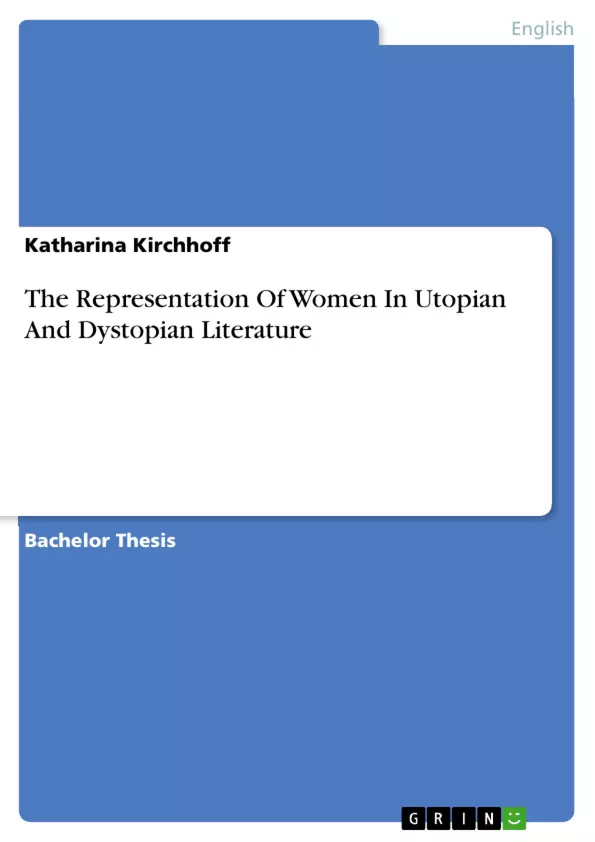The purpose of this study is to analyse the representation of women in utopian and dystopian literature. The research question of this paper is: To what extent is the representation of women and their status in the fictional societies determined by gender relations in the context of the distribution of power?
To explore this question the historical context in which s/he wrote the novel is also assumed to be important. The approach applied to this thesis is based on gender and literary studies. In order to analyse the representation of women, this thesis offers a coherent structure consisting of four important steps. Firstly, each novel will be introduced with a brief paragraph on the historical background. Secondly, the power relations of the society have to be observed. Thirdly, the resulting gender relations will be analysed. Finally, in the context of the prior three steps of this thesis, the representation of women will be observed. In addition, I will use traditional female stereotypes in literature as a criterion for the analysis of the representation of women.
The novels chosen for this purpose are Herland, written by Charlotte Perkins Gilman in 1915, followed by the dystopia Brave New World, written by Aldous Huxley in 1932. The final novel will be the dystopia The Handmaid’s Tale, written by Margarete Atwood in 1985. The last section of this thesis will compare the results of the analyses and clarify in how far power and gender relations determine the representation of women in utopian and dystopian literature in the light of the historical context of the novel.
Inhaltsverzeichnis (Table of Contents)
- Abstract
- 1. Introduction
- 1.1 Research Field
- 1.2 Selection of Novels
- 1.3 Structure and Methodology
- 2. Theoretical Aspects
- 2.1 Definition of Utopia and Dystopia
- 2.2 Traditional Stereotypes in Literature
- 3. The Representation of Women in Herland
- 3.1 Historical Context
- 3.2 A Country Called Herland
- 3.3 Gender
- 3.4 Women in Herland
- 4. The Representation of Women in Brave New World
- 4.1 Historical Background
- 4.2 The World State
- 4.3 Gender
- 4.4 Women in the World State
- 5. The Representation of Women in The Handmaid's Tale
- 5.1 Historical Context
- 5.2 The State of Gilead
- 5.3 Gender
- 5.4 Women in Gilead
- 6. Discussion and Conclusion
- 7. Works Cited
Zielsetzung und Themenschwerpunkte (Objectives and Key Themes)
This bachelor thesis aims to analyze the representation of women in utopian and dystopian literature. It explores the extent to which gender relations within power structures determine the portrayal of women and their status in fictional societies. The study considers the historical context of each novel as a crucial factor in shaping the representation of women.
- The relationship between power structures, gender relations, and the representation of women in utopian and dystopian literature.
- The influence of traditional female stereotypes on the portrayal of women in these fictional societies.
- The historical context as a key factor shaping the representation of women in utopian and dystopian novels.
- The use of literary techniques to construct particular 'types' of women in utopian and dystopian narratives.
- The development of feminist literature and gender studies in relation to the representation of women.
Zusammenfassung der Kapitel (Chapter Summaries)
The introductory chapter lays out the research field, the selection of novels, and the structure and methodology of the thesis. It highlights the intersection of Literary Studies and Gender Studies, emphasizing the historical marginalization of female writers and the rise of feminist literature and gender studies.
Chapter 2 delves into theoretical aspects, defining utopia and dystopia and exploring the role of traditional female stereotypes in literature. It argues that stereotypes reflect society's perceptions and expectations of women, often shaped by a male-dominated historical context.
Chapter 3 analyzes the representation of women in Charlotte Perkins Gilman's Herland. It examines the historical context of the novel, the unique society of Herland, the portrayal of gender relations, and the specific representation of women within this utopian society.
Chapter 4 examines the representation of women in Aldous Huxley's Brave New World. It explores the historical background of the novel, the dystopian society of the World State, the prevailing gender relations, and the portrayal of women within this controlled environment.
Chapter 5 analyzes the representation of women in Margaret Atwood's The Handmaid's Tale. It explores the historical context of the novel, the dystopian society of Gilead, the subjugation of women, and their specific roles and experiences in this totalitarian regime.
Schlüsselwörter (Keywords)
The key terms and focus topics of this thesis include the representation of women, utopian and dystopian literature, gender relations, power structures, traditional female stereotypes, feminist literature, gender studies, historical context, literary techniques, and societal norms.
- Quote paper
- Katharina Kirchhoff (Author), 2012, The Representation Of Women In Utopian And Dystopian Literature, Munich, GRIN Verlag, https://www.grin.com/document/208924



